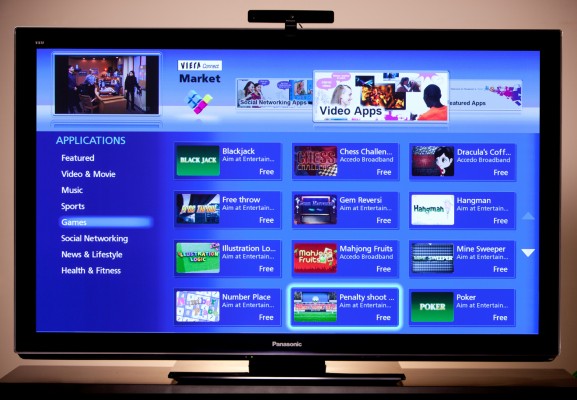
If you listen to the marketing, 2011 is the year of the Smart TV. Not only are TV manufacturers launching televisions with internet connectivity built-in, they are developing their own platforms and SDKs for developers to create a new era of TV-based applications. It’s inevitable that TV apps are going to become mainstream, but before they do Consumer Electronics should be working together to create a uniform standard across the industry.
At the moment, the TV industry sits on the edge of the TV app lake, debating whether or not the water’s warm enough to go swimming. Over the past few years, we’ve seen companies dip their toes in the water, with support for things like Facebook and Picasa through the television. This year though, companies like Samsung, LG and Panasonic have all waded out to their chests, working up the courage to put their head under the water. Sony’s there too, holding Google’s hand waiting to step a bit deeper.
Okay, so the metaphor is starting to get a bit forced. But what we’re left with is a bunch of companies getting ready to pave their own way through the lake of online TV applications, without necessarily stopping to think about the consumer.
We’ve already seen in the mobile marketplace what happens with multiple operating systems. Companies like Apple take a closed approach, controlling every aspect of the app’s distribution and taking a tidy cut of the profits. And at the moment this looks like the approach most TV companies are going to take, launching their own portals, own SDKs and own user interfaces.
The problem with this approach when it comes to TVs is that there are so many manufacturers out there that it will inevitably end up confusing the consumer, especially as manufacturers do deals with content providers to offer apps exclusively. We’ve already seen how frustrating it can be with IPTV partners – having access to something like Yahoo!7 Plus through Sony TVs but not Samsung, while BigPond Movies comes with Samsung and not Sony helps nobody looking for a reliable IPTV option in their television.
The other approach taken my mobile phone apps is the more open sourced one from Google Android, and it’s no surprise that it’s the search giant leading the way in this way for the television industry as well. Even though it hasn’t launched in Australia, an open platform for TV apps like Google TV makes the playing field relatively level, and allows customers to make their purchasing decision on quality of panel rather than content restrictions.
This is why the TV manufacturers need to standardise their approach to TV apps. It could be that they use a platform like Google TV or develop their own, but in the end, it will give the consumer a much more reliable offering. They will be able to willingly purchase both apps and services, knowing that should they upgrade their TV in the future, they won’t lose the ability to keep those same apps. Or share those apps across several TVs in the same house, depending on how the platform was setup.
It would also allow developers to focus on creating superior applications, rather than trying to port the app across four or more different platforms. And better apps will undoubtedly lead to more satisfied customers willing to spend more money.
But despite all that, the reality is that seeing a uniform app platform across multiple brands in the TV space is exceptionally unlikely. No doubt, each manufacturer sees online content as a potentially lucrative market if it can be sold to consumers properly. And few would be able to resist the siren song of a closed system after looking at the huge success Apple is having with iTunes and iOS.
If there’s any hope for seeing a uniform TV app platform, it would need to happen soon, before the manufacturers swim too far away from the shore where they can help prevent each other from drowning.